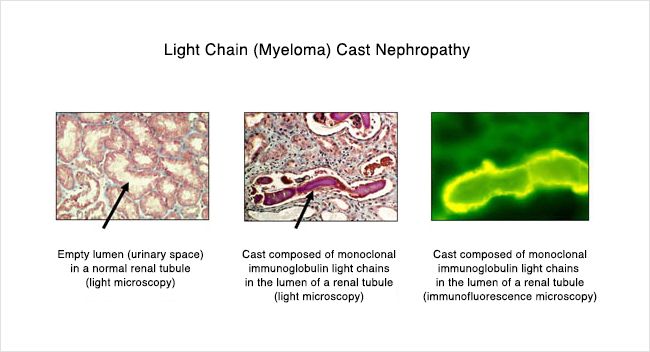Light Chain Deposition Disease
Contents
What is Light Chain Deposition Disease?
Your body fights infection with antibodies. Antibodies are made up of small protein segments called light chains and heavy chains. Certain cells in your body called B-cells often make “extra” light chains, that are broken down into small pieces by the kidney, which are then reabsorbed and used again in your body.
Patients with light chain deposition disease make far too many light chains, which get deposited in lots of different tissues in the body, including the kidney. Some patients with light chain deposition disease will make so many that they overwhelm the kidneys’ ability to recycle or get rid of them all, and some of those proteins get stuck in the kidney. There are quite a few proteins that can be deposited in the kidney that resemble light chain deposition, but your doctor can tell the difference based on the pattern they make when seen under a strong microscope (electron microscope).
Read information on heavy chain deposition disease.
Read information on AL amyloidosis.
Read information on cyoglobulinemia.
What does it look like (under the microscope)?
Light chains can be seen in the kidney biopsy tissue using an electron microscope. The pathologist viewing the biopsy can tell it is light chain deposition disease because it has a different appearance from other deposition diseases. In other deposition diseases, the chains will appear to form a pattern and are found in one particular section of the kidney. In light deposition disease, the chains do not form a pattern and can be found in various sections of the kidney. The pathologist will use a special stain on the microscope to be able to see these differences.

How did I get it?
Light chain deposition usually occurs along with another disease affecting the whole body. The risk of developing light chain deposition varies significantly depending on the other disease that the patient has. Patients with this disease typically are over the age of 50 and have an average age of 67. The disease is more common in men than in women.
What are the symptoms?
The symptoms a person has vary based on the reason for the light chain production. Symptoms can be related to the disease as it affects your body as a whole, such as weakness and fatigue, weight loss, bone pain, or numbness/tingling of your arms or legs.
Deposition of light chains in the heart muscle is seen in about 80% of patients with this disease, and symptoms related to the heart muscle damage can be more prominent than symptoms from the kidney.
Many people who develop kidney disease first may not notice anything, but have changes in their urine such as losing protein, blood, sugar, or acid. Some people will notice swelling, frequent urination and thirst.
What is the treatment?
Therapy usually is focused on treating the underlying disease, and can vary. There are some things we can do to help reduce further damage done to the kidney by the light chain deposition. These include decreasing the amount of calcium in your urine, which is done by staying well hydrated, and reducing the amount of acid in the urine. Sometimes patients will take a diuretic, which is a medicine to increase the amount of urine a person makes.
What is the prognosis?
The outcome of patients with light chain deposition disease remains uncertain. In large part this is related to the effects of light chains in other organs and not necessarily due to kidney disease. Patient survival from the time that symptoms begin has ranged from 1 month to 10 years. Although the prognosis for long term kidney health is poor, there are some studies which have shown that some patients have done relatively well.